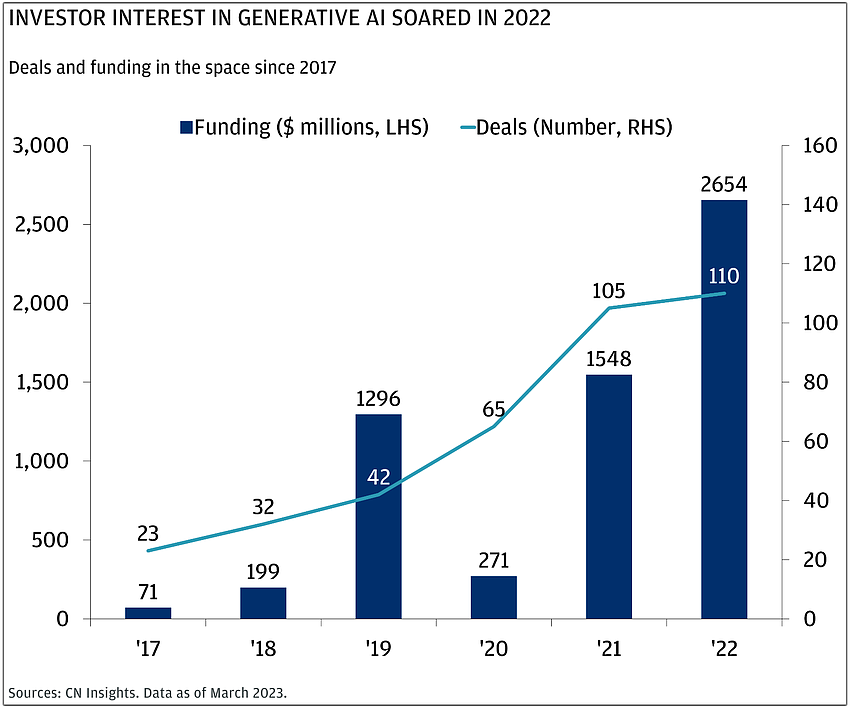- July 26, 2024
-
-
Loading

Loading
 Illustration by Luis Trujillo
Illustration by Luis Trujillo
Artificial intelligence and its connected creations and inventions can be reality-check scary or a real-life guide to enhanced efficiency.
For many executives and entrepreneurs — at least in the early stages of the AI and ChatGPT revolution — it appears to be a bit of both.
That’s an unscientific consensus from interviews, casual conversations and panel discussions sponsored by chambers of commerce and other groups across the region in the past few months. What’s even more of a certainty: Interest in figuring out how to use the new technology, and what it can and can’t do, is overflowing — and coming for all business and nonprofit corners.
“Artificial intelligence isn’t going away. ChatGPT isn’t going away,” says Mark Koulianos, executive director of Corporate Training and Professional Education at the University of South Florida. With that staying power in mind, Koulianos and his team, a division of the USF Innovation Education department, recently launched a three-hour class titled “Exploring AI and ChatGPT: Impact and Possibilities.”
“We want to help people optimize how to use the technology,” Koulianos says, “so it can become another tool you can use, like Microsoft Office was back in the day.”
The USF virtual class, which culminates in an AI and ChatGPT Certificate, had several thousand enrollees when it debuted. And that tally blew through several pre-arranged maximum attendee levels. “We had to keep raising the cap because there was so much interest,” Koulianos says.
Christine Brown, associate vice president of Innovation education at USF, adds that the interest was from doers, not merely the academically curious. “People wanted more hands-on information,” Brown says.
The trick, to the point Koulianos makes about AI and ChatGPT being a tool, is to figure out what works and what doesn’t for your specific business needs, say several executives who have used the technology.
On the works side, Andrew Neitlich, an executive coach based in Osprey, south Sarasota County, sums up some of the ways “AI has augmented” his business in a recent LinkedIn post. The list includes:
Yet like many other AI users and adapters, Neitlich is cautious. He calls the output impressive, while adding, “I had to edit a lot of the above to get it ready for use. More importantly, it still can't work with clients to help them break through to new levels of performance. It can suggest simple ideas, but it can't do the heavy lifting that a human can do. Maybe one day, but not yet.”
He added that he saw a demonstration of an AI-generated avatar leading a training session, “but it looked a little creepy and isn't quite ready for prime time.”
Another real life example of both the uses and limitations comes from David Grace, owner of Abacus Web Services in Sarasota. He spoke during a May 23 seminar at the Manatee Chamber of Commerce in downtown Bradenton on using AI for small business marketing. Grace talked about using text to generate images and video, specifically using the images for building a marketing campaign, social media posts, advertisements, webinars and blog posts.
“You can certainly get a graphic designer to generate these (images),” Grace says. “You could send them instructions and they could show you drafts. But for the rest of us, we can (utilize) these tools.”

In an example using Stable Diffusion, an AI platform, Grace entered the prompt “lions chasing a hyena in downtown Glasgow, Scotland, on a wet day.”
The picture it created showed three lions, one with a messed up leg, running down a wet street. The hyena was a no-show.
The upshot? Another example of the cool factor mixed with not-yet-ready factor.
“With these use cases you have to think about ‘what do I want to achieve?’” Grace says. “Because this lets you do things you couldn’t do, it lets you do it quicker and presumably for much lower cost. That’s the power of this stuff.”
Another one in the ‘just a tool’ camp is Kevin McNulty, president and CEO of Bradenton social media agency NetWeave Social, who also spoke at the Manatee Chamber event. “AI is not going to replace marketers,” McNulty says. “Marketers who use AI are going to replace marketers who don’t.”
McNulty, though, offers a caveat: in the example of self-driving cars, there might be some truth to AI taking over our jobs.
“You don’t have to get the AI to never crash,” McNulty says. “You just have to have it crash less than a human being.”
“The second a trucking company’s insurance premium goes down when they buy a self-driving truck, all of the drivers will be out of a job,” he adds. “We’re going to have to rethink what it means to make a living, eventually.”
Another entity in the region that’s found a practical use for AI is Tampa General Hospital. The 1,040-bed hospital recently announced a collaboration with Navina, an Israeli company that specializes in AI-powered solutions for physicians and other members of a medical facility’s care team. Founded in 2018, Navina has raised about $44 million in venture capital, to date, according to Crunchbase.com. In October 2022, it announced it had raised $22 million in a Series B funding round.
In a news release, Navina says its platform can “turn chaotic data into an intuitive and concise patient portrait,” allowing medical professionals to “assess, collaborate and act on even the most complicated cases instantly.”
The patient information can include lab results, consultation notes, imaging and many other types of data. According to the release, AI-driven consolidation of all that information reduces data overload, leading to better treatment, reduced missed diagnoses and a lessened burden on physicians. The latter benefit, TGH officials say, can help reverse a big problem in health care: doctor and nurse burnout.
“Complete clinical information is available on a summary screen for chart preparation before an appointment, thereby reducing review time for the clinicians,” says Dr. Karna Patel, vice president of Tampa General Medical Group, in the statement.
But while the technology is useful and cutting-edge, it’s not a doctor replacement mechanism, officials stress. That’s why Navina Chief Medical Officer Yair Lewis, in an interview with the Business Observer, says the AI won’t be making any decisions based on the data it collects and organizes. Patients shouldn’t expect any sudden and unexplained changes to their prescriptions, for example.
“It assists by pointing out information for the doctor and streamlining the workflow,” he says. “We’re not deciding whether a patient has a disease, and we’re definitely not recommending treatments.”
Lewis says Navina — licensed to medical facilities as Software as a Service, generating monthly recurring revenue for the company — integrates into the electronic health record management systems already in use by customers, so doctors won’t have to learn to use a new software application.
“We realized that if you want to have impact and want to be useful, clinicians aren't going to be logging on to different systems,” he says. “They're not going to open a different window. It’s fully integrated within the EHR, sort of like an overlay.”
The ease of access to information leads directly to time-saving measures, Lewis adds, such as giving doctors the ability to have the AI write notes based on recent lab results. A draft is then presented to the physician for approval or revision, and then he or she writes a conclusion with treatment recommendations.
“They can tell the system, ‘Hey, put in an order for such and such medication,’” he says. That’s normally a process that can take up to 10 clicks on various screens, but the AI can automate most of that process, saving a lot of time for the doctor.”